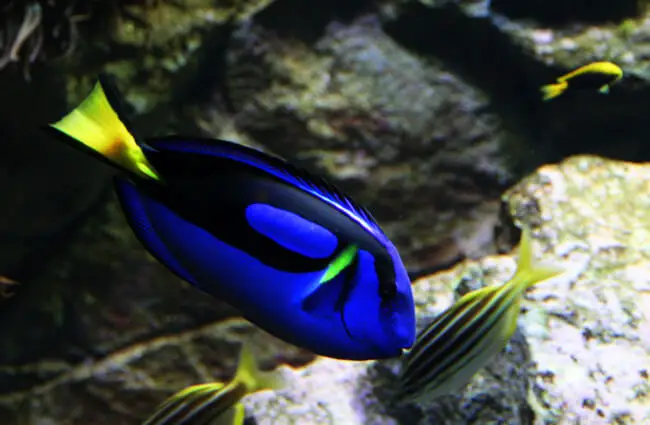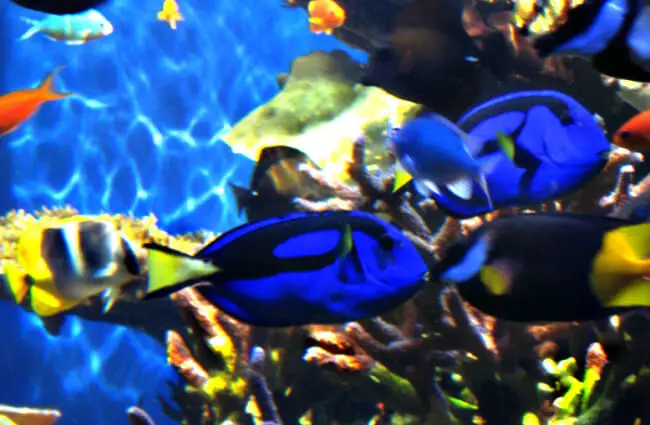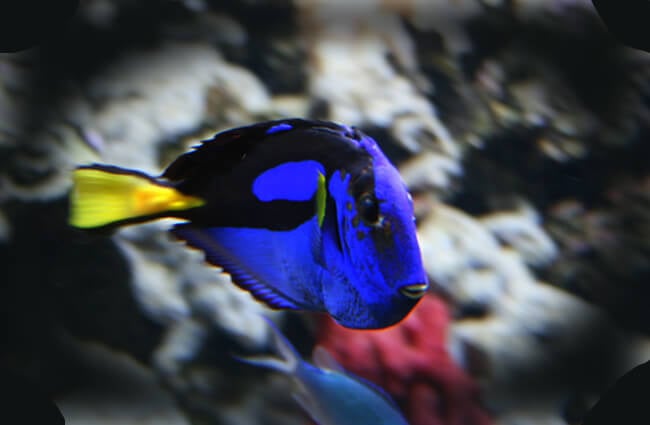The ocean’s vibrant tapestry is home to countless wonders, but few capture the human imagination quite like the fish affectionately known as “Dory.” This striking creature, scientifically identified as the Regal Blue Tang, is far more than just a cartoon character. It is a fascinating inhabitant of coral reefs, playing a vital role in its ecosystem and exhibiting behaviors that intrigue scientists and enthusiasts alike. From its dazzling blue and yellow hues to its unique feeding habits, the Regal Blue Tang offers a captivating glimpse into the intricate world beneath the waves.
This article delves deep into the life of the Regal Blue Tang, exploring its biology, habitat, ecological significance, and its surprising journey into popular culture. Whether you are a student researching marine life, an aspiring zoologist, an animal lover hoping to spot one in the wild, or even a zookeeper caring for these magnificent fish, prepare to discover the true story of the ocean’s most famous blue resident.

The Iconic Blue Tang: A Splash of Color in the Ocean
Who is Dory? Unveiling the Regal Blue Tang
The Regal Blue Tang, Paracanthurus hepatus, is instantly recognizable by its vivid royal blue body, striking yellow caudal fin (tail), and a distinctive black “palette” mark that extends from the eye, along the dorsal fin, and curves back towards the tail. This unique coloration serves not only as a visual spectacle but also likely plays a role in species recognition and communication within its marine environment. While juveniles may display a more yellowish hue, adults consistently exhibit the iconic blue. These fish possess a laterally compressed body, meaning they are thin from side to side, allowing them to navigate tight spaces within the reef structure with agility. An interesting anatomical feature is the presence of sharp, scalpel-like spines located on either side of the caudal peduncle, the narrow part of the body connecting to the tail. These spines, which can be extended, are a defensive mechanism, giving the fish its common name “tang” or “surgeonfish.”

Where the Ocean’s Jewel Resides: Dory’s Habitat
The Regal Blue Tang is a denizen of the Indo-Pacific region, a vast expanse of tropical waters stretching from East Africa to the central Pacific Ocean. Its preferred habitat is the vibrant and complex ecosystem of coral reefs. These fish are typically found in shallow, clear waters, often congregating around the outer reef slopes and lagoons where there is an abundance of live coral and rocky substrates. They thrive in areas with strong currents that bring a constant supply of plankton and facilitate the growth of algae, their primary food source. Animal lovers hoping to find a Regal Blue Tang in the wild should focus their search on these warm, tropical coral reef environments, particularly during daylight hours when the fish are most active. Snorkeling or diving in healthy reef systems in countries like Indonesia, the Philippines, Australia (Great Barrier Reef), and various Pacific island nations offers the best chance of an encounter.

A Day in the Life: What Dory Eats
The diet of the Regal Blue Tang is primarily herbivorous, making it an essential grazer on coral reefs. As juveniles, they predominantly feed on plankton, tiny organisms drifting in the water column. However, as they mature, their diet shifts significantly to macroalgae and filamentous algae that grow on rocks and corals. They use their small, comb-like teeth to scrape algae from surfaces, a feeding behavior crucial for the health of the reef. By consuming algae, they prevent it from overgrowing and smothering corals, thereby maintaining the delicate balance of the coral reef ecosystem. This dietary preference also means they are constantly foraging throughout the day, often seen darting between coral heads, meticulously cleaning surfaces. Their role as an algal grazer is a cornerstone of reef resilience.

Life Cycle and Social Dynamics of the Blue Tang
The Dance of Life: Mating and Reproduction
The reproductive process of the Regal Blue Tang is a fascinating display of marine biology. These fish are pelagic spawners, meaning they release their eggs and sperm directly into the water column, where fertilization occurs externally. Spawning typically happens in groups, often at dusk, with several males pursuing a single female. The female releases thousands of tiny, buoyant eggs, which are then fertilized by the males. There is no parental care after the eggs are released. The fertilized eggs drift with the ocean currents, developing into larvae. This strategy allows for wide dispersal of offspring, increasing the chances of survival and colonization of new areas.
From Tiny Larva to Reef Resident: Growth and Development
The larval stage of the Regal Blue Tang is planktonic, lasting for several weeks. During this period, the larvae are at the mercy of ocean currents and face numerous predators. They undergo several developmental changes, gradually transforming into miniature versions of the adult fish. Once they are sufficiently developed, they settle onto suitable reef habitats, transitioning from a planktonic existence to a benthic one. Juveniles are often more secretive, hiding among corals for protection. As they grow, they become more confident and join schools of other tangs. The lifespan of a Regal Blue Tang in the wild can range from 8 to 12 years, though some individuals may live longer under optimal conditions.

Social Circles: Dory’s Interactions with Other Marine Life
Regal Blue Tangs are generally social fish, often found in small groups or larger aggregations, especially during feeding. Schooling behavior provides a degree of protection against predators, as there is safety in numbers. They are known to interact peacefully with a wide variety of other reef fish species. While they are not known for direct symbiotic relationships like clownfish and anemones, their grazing activities benefit the entire reef community. They are prey for larger predatory fish such as groupers and snappers, and their schooling behavior is a primary defense mechanism against such threats. Their presence is a good indicator of a healthy reef ecosystem.

The Blue Tang’s Place in the Grand Tapestry of Life
An Ancient Lineage: The Evolution of the Regal Blue Tang
The Regal Blue Tang belongs to the family Acanthuridae, commonly known as surgeonfish. This family is characterized by the presence of the aforementioned scalpel-like spines on their caudal peduncle. Surgeonfish have a long evolutionary history, with fossil records indicating their presence dating back tens of millions of years. Their evolution is closely tied to the development of coral reefs, as their specialized herbivorous diet makes them integral to these ecosystems. Over millennia, they have adapted to graze efficiently on algae, developing unique mouthparts and digestive systems suited for this purpose. Their vibrant coloration is also a product of evolutionary pressures, likely for camouflage, signaling, or species recognition in the visually complex reef environment.
Ecosystem Engineers: Dory’s Contribution to Coral Reefs
The role of the Regal Blue Tang in the coral reef ecosystem cannot be overstated. As primary consumers, they are vital for controlling algal growth. Without grazers like the blue tang, algae can quickly proliferate, outcompeting and eventually smothering slow-growing corals. This algal control helps maintain the structural integrity and biodiversity of the reef. By keeping algae in check, they create space for coral larvae to settle and grow, ensuring the reef’s continued health and resilience. They also contribute to nutrient cycling by consuming algae and then excreting waste, which can be utilized by other organisms. Their presence is a key indicator of a thriving reef system.

Dory and Humanity: From Screen to Conservation
A Star is Born: Dory’s Impact on Human Culture
The Regal Blue Tang gained unprecedented global recognition through its portrayal as “Dory” in popular animated films. This cultural phenomenon brought the species into millions of homes, sparking widespread interest in marine life and coral reefs. The character’s endearing personality and memorable catchphrases made the blue tang an instant icon, significantly raising public awareness about this specific fish and, by extension, the broader issues facing ocean ecosystems. This cultural spotlight has been a double-edged sword, however, as increased demand for the fish in the aquarium trade has also presented challenges.
Encounters in the Wild: Observing Dory Responsibly
For an animal lover or aspiring zoologist hoping to encounter a Regal Blue Tang in its natural habitat, responsible observation is paramount. When snorkeling or diving in coral reefs, always maintain a respectful distance. Avoid touching corals or any marine life, as this can cause stress or damage. Observe their natural behaviors, such as grazing on algae or schooling with other fish. A hiker, perhaps better described as a diver or snorkeler in this context, encountering a Regal Blue Tang should simply enjoy the spectacle. Do not attempt to feed them, chase them, or interfere with their environment. The best interaction is a passive one, allowing these beautiful creatures to continue their vital work on the reef undisturbed.

Guardians of the Reef: Human Interactions and Conservation
Human interaction with Regal Blue Tangs extends beyond observation. The species faces threats primarily from habitat degradation due to climate change, pollution, and destructive fishing practices. The popularity of “Dory” also led to a surge in demand for the species in the aquarium trade, often sourced from wild populations. This has prompted concerns about overcollection and unsustainable practices. Conservation efforts focus on protecting coral reef habitats, promoting sustainable aquaculture for the aquarium trade, and educating the public about responsible pet ownership and marine conservation. Supporting organizations dedicated to reef protection and choosing sustainably sourced marine life are crucial steps in ensuring the future of the Regal Blue Tang.
Caring for Dory: Insights for Aquarists and Zookeepers
The Art of Captive Care: Providing a Thriving Environment
Caring for a Regal Blue Tang in captivity, whether in a home aquarium or a public zoo exhibit, requires specialized knowledge and dedication. These fish need spacious tanks, ideally 100 gallons or more for a single adult, to accommodate their active swimming habits and potential adult size of up to 12 inches. The tank must be well-established with mature live rock to provide grazing surfaces and hiding spots. Water parameters are critical: stable salinity (1.023-1.025 specific gravity), temperature (75-82°F), and pristine water quality with undetectable ammonia and nitrite, and low nitrates. A robust filtration system, including protein skimming, is essential. Diet in captivity should mimic their natural herbivorous tendencies, consisting of high-quality marine algae, spirulina flakes, and various seaweed sheets, supplemented with occasional meaty foods like mysis shrimp to ensure a balanced nutritional intake. Providing ample water flow is also beneficial, simulating their natural reef environment.
Daily Duties and Delicate Balances: Zookeeper’s Guide
For zookeepers, the care of Regal Blue Tangs involves a comprehensive daily routine and a deep understanding of their needs. Key tasks include:
- Daily Feeding: Offering a varied diet of marine algae, spirulina, and other herbivore-specific foods multiple times a day.
- Water Quality Monitoring: Regular testing of salinity, temperature, pH, ammonia, nitrite, and nitrate levels to ensure optimal conditions.
- Tank Maintenance: Cleaning tank glass, siphoning detritus, and performing regular water changes to maintain pristine water quality.
- Health Checks: Observing fish for any signs of disease, injury, or unusual behavior. Blue tangs are susceptible to marine ich (white spot disease), so vigilance is crucial.
- Enrichment: Providing varied rockwork, coral structures, and strong water flow to encourage natural behaviors.
What to avoid:
- Overcrowding: This leads to stress, aggression, and poor water quality.
- Incompatible Tank Mates: Aggressive fish can harass blue tangs, while overly docile fish might be outcompeted for food.
- Sudden Environmental Changes: Maintain stable parameters to prevent stress and disease outbreaks.
- Insufficient Algae: A lack of grazing material can lead to nutritional deficiencies and behavioral issues.
- Handling Without Care: The caudal spines are sharp; use caution if handling is absolutely necessary.
Fascinating Facts About the Regal Blue Tang
- The Regal Blue Tang can change the intensity of its blue coloration, often appearing darker when stressed or at night.
- They possess a unique defense mechanism: the sharp, retractable spines on their caudal peduncle, which can inflict painful wounds.
- Despite their common name “Dory,” the species has no known memory issues in the wild.
- Juvenile blue tangs are often more yellow than blue, gradually developing their adult coloration as they mature.
- They are primarily diurnal, meaning they are active during the day and seek shelter in reef crevices at night.
- Regal Blue Tangs are important “bio-eroders” on the reef, as their grazing helps prevent algal overgrowth.
- They can produce a clicking sound, though the exact purpose of this vocalization is not fully understood.
- In some parts of their range, they are harvested for food, though their small size makes them less desirable than larger fish.
- Their scientific name, Paracanthurus hepatus, refers to their close relation to other surgeonfish (Acanthuridae) and a liver-like spot on some individuals.
The Regal Blue Tang is a testament to the incredible biodiversity and intricate ecological balance of our planet’s oceans. From its stunning appearance and vital role as a reef grazer to its unexpected journey into popular culture, this fish offers endless avenues for discovery and appreciation. Understanding its life, habitat, and interactions with both its environment and humanity underscores the importance of marine conservation. By continuing to learn about and protect species like the Regal Blue Tang, we ensure that the vibrant beauty and ecological health of our coral reefs endure for generations to come.

![Red Angus Closeup of a beautiful Red Angus cowPhoto by: U.S. Department of Agriculture [pubic domain]https://creativecommons.org/licenses/by/2.0/](https://animals.net/wp-content/uploads/2020/03/Red-Angus-4-238x178.jpg)




![Red Angus Closeup of a beautiful Red Angus cowPhoto by: U.S. Department of Agriculture [pubic domain]https://creativecommons.org/licenses/by/2.0/](https://animals.net/wp-content/uploads/2020/03/Red-Angus-4-100x75.jpg)

